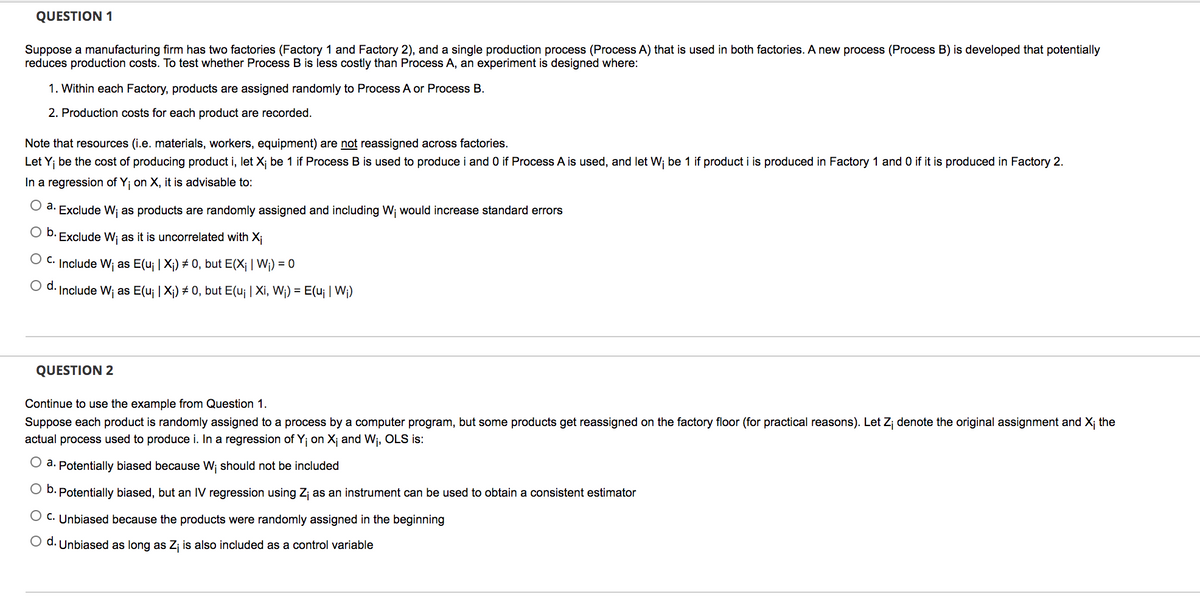QUESTION 1 Suppose a manufacturing firm has two factories (Factory 1 and Factory 2), and a single production process (Process A) that is used in both factories. A new process (Process B) is developed that potentially reduces production costs. To test whether Process B is less costly than Process A, an experiment is designed where: 1. Within each Factory, products are assigned randomly to Process A or Process B. 2. Production costs for each product are recorded. Note that resources (i.e. materials, workers, equipment) are not reassigned across factories. Let Y be the cost of producing product i, let X; be 1 if Process B is used to produce i and 0 if Process A is used, and let W; be 1 if product i is produced in Factory 1 and 0 if it is produced in Factory 2. In a regression of Y on X, it is advisable to: O a. Exclude W; as products are randomly assigned and including W; would increase standard errors O b. Exclude Wi as it is uncorrelated with X O C. Include W; as E(u | X) # 0, but E(X; | W;) = 0 O d. Include W; as E(u¡ | X¡) # 0, but E(u; | Xi, W;) = E(u¡ | W)
QUESTION 1 Suppose a manufacturing firm has two factories (Factory 1 and Factory 2), and a single production process (Process A) that is used in both factories. A new process (Process B) is developed that potentially reduces production costs. To test whether Process B is less costly than Process A, an experiment is designed where: 1. Within each Factory, products are assigned randomly to Process A or Process B. 2. Production costs for each product are recorded. Note that resources (i.e. materials, workers, equipment) are not reassigned across factories. Let Y be the cost of producing product i, let X; be 1 if Process B is used to produce i and 0 if Process A is used, and let W; be 1 if product i is produced in Factory 1 and 0 if it is produced in Factory 2. In a regression of Y on X, it is advisable to: O a. Exclude W; as products are randomly assigned and including W; would increase standard errors O b. Exclude Wi as it is uncorrelated with X O C. Include W; as E(u | X) # 0, but E(X; | W;) = 0 O d. Include W; as E(u¡ | X¡) # 0, but E(u; | Xi, W;) = E(u¡ | W)
Managerial Economics: A Problem Solving Approach
5th Edition
ISBN:9781337106665
Author:Luke M. Froeb, Brian T. McCann, Michael R. Ward, Mike Shor
Publisher:Luke M. Froeb, Brian T. McCann, Michael R. Ward, Mike Shor
Chapter17: Making Decisions With Uncertainty
Section: Chapter Questions
Problem 17.3IP
Related questions
Question

Transcribed Image Text:QUESTION 1
Suppose a manufacturing firm has two factories (Factory 1 and Factory 2), and a single production process (Process A) that is used in both factories. A new process (Process B) is developed that potentially
reduces production costs. To test whether Process B is less costly than Process A, an experiment is designed where:
1. Within each Factory, products are assigned randomly to Process A or Process B.
2. Production costs for each product are recorded.
Note that resources (i.e. materials, workers, equipment) are not reassigned across factories.
Let Y¡ be the cost of producing product i, let X; be 1 if Process B is used to produce i and 0 if Process A is used, and let W; be 1 if product i is produced in Factory 1 and 0 if it is produced in Factory 2.
In a regression of Y; on X, it is advisable to:
O a. Exclude W; as products are randomly assigned and including W; would increase standard errors
Ob.
· Exclude W; as it is uncorrelated with X;
O C. Include W; as E(u¡ |X¡) ± 0, but E(X¡ | W;) = 0
O d. Include Wị as E(u¡ | X;) # 0, but E(u¡ | Xi, W¡) = E(u¡ | W¡)
QUESTION 2
Continue to use the example from Question 1.
Suppose each product is randomly assigned to a process by a computer program, but some products get reassigned on the factory floor (for practical reasons). Let Z¡ denote the original assignment and X; the
actual process used to produce i. In a regression of Y¡ on X¡ and Wi, OLS is:
O a. Potentially biased because W; should not be included
O b. Potentially biased, but an IV regression using Z¡ as an instrument can be used to obtain a consistent estimator
O C. Unbiased because the products were randomly assigned in the beginning
O d. Unbiased as long as Z; is also included as a control variable
Expert Solution
This question has been solved!
Explore an expertly crafted, step-by-step solution for a thorough understanding of key concepts.
This is a popular solution!
Trending now
This is a popular solution!
Step by step
Solved in 3 steps

Knowledge Booster
Learn more about
Need a deep-dive on the concept behind this application? Look no further. Learn more about this topic, economics and related others by exploring similar questions and additional content below.Recommended textbooks for you

Managerial Economics: A Problem Solving Approach
Economics
ISBN:
9781337106665
Author:
Luke M. Froeb, Brian T. McCann, Michael R. Ward, Mike Shor
Publisher:
Cengage Learning


Managerial Economics: A Problem Solving Approach
Economics
ISBN:
9781337106665
Author:
Luke M. Froeb, Brian T. McCann, Michael R. Ward, Mike Shor
Publisher:
Cengage Learning
